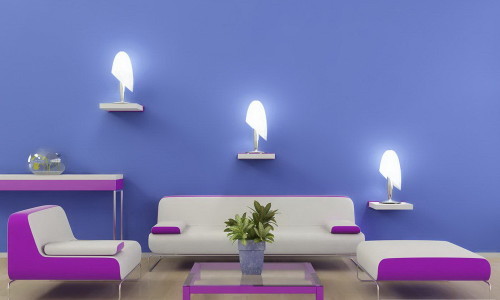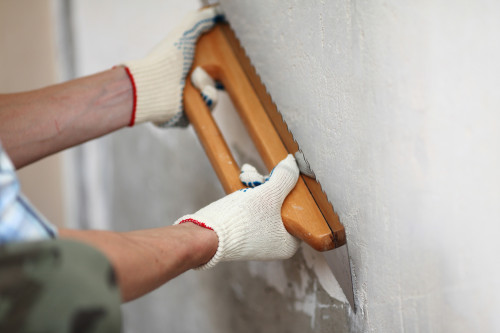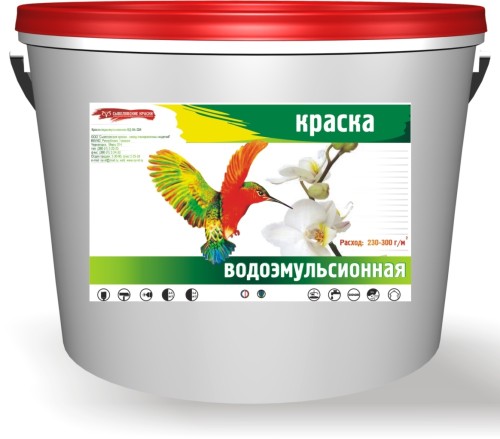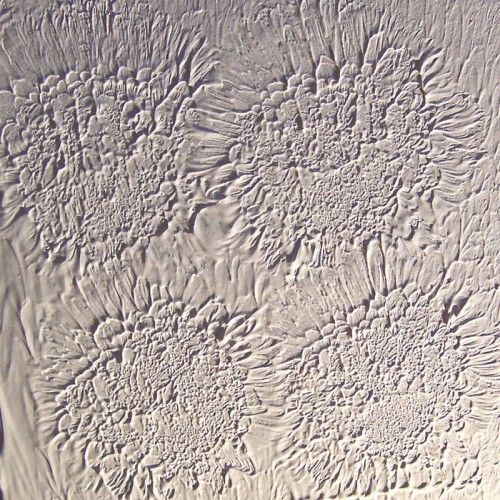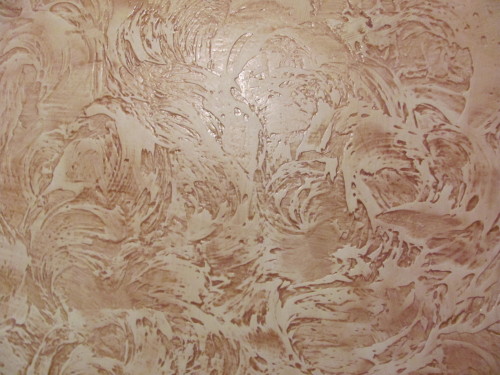Wall painting is a cheap and simple way to finish the surface. On the nuances of the implementation of this process and will be discussed in our article.
Content
Basic technology painting walls
The price of the wall color depends on what kind of work will be selected. Distinguish three types of wall coloring:
- simple;
- improved;
- high quality.
Simple painting consists of 5 main stages:
- surface cleaning;
- her alignment;
- elimination of defects;
- grinding walls;
- painting.
Improved wall color involves the execution of 8 consecutive actions:
- cleaning of walls;
- their leveling;
- elimination of defects;
- applying the first layer of primer;
- shtlocking of rough sections;
- grinding plots with putty;
- applying the second layer of primer;
- staining walls.
High-quality wall color differs from improved in that it includes two continuous shtlocks of the walls and two surface grinding, as well as applying the third layer of primer before staining.
Preparation of the surface
At this stage, it is carried out:
- removal of old coating;
- removal of contaminants;
- alignment of walls;
- similar to the surface.
Removing the old coating
This process involves performing actions depending on the type of old coating:
- the repeated surface is cleaned with a spatula;
- the whols are removed by a brush that is impregnated with water;
- the glue surface is wetted by hot water with the subsequent removal of the spatula;
- if the glue surface has not been removed, the hydrochloric acid solution is used (2-3%).
In most cases, you will have to face the removal of old wallpaper. To remove conventional paper wallpapers, it is sufficient to moisten them with water. When contacting with water, wallpaper swelling occurs. Moisto enters glue under the wallpaper. As a result, wallpaper from walls without problems are removed along with glue.
A little more complicated about the case with waterproof material (vinyl wallpaper). In this case, the wallpapers are impregnated with several water layers. It is recommended to mix water with cellulose glue, thanks to which water is held in the pores of glue for a longer time. It is also possible to remove wallpaper from the wall using a special electrical sweeping.
Removal of pollution
Dirt, rust, soot, fat stains - all these defects should be eliminated before painting walls. If this does not produce, then the pollution is commemorated through the film of the paintwork.
The removal of soot and fatty spots is carried out with the help of a 5% solution of soda calcined. To do this, 0.4-0.5 kg of soda is dissolved in the water bucket. To clean the surface from the soot, you can also use a 3% solution of hydrochloric acid.
To remove rust can be enough and hot water. After that, the surface is processed by a 10% copper sulfate solution. If the rust leaks still remain on the wall, then it is possible to make them imperceptible with the help of rolling varnish, primers for metal or white enamel, which dries quickly.
In the presence of a reinforcing mesh, under the stunned surface, it is possible to avoid the appearance of rust on the wall by applying acrylic primer.
Alignment of walls
An integral part of the wall color of the wall is the level alignment. Nowadays, plasterboard or plaster are used for these purposes.
With the help of drywall, you can perfectly align the surface. Exists two techniques Its installation:
- on a metal frame;
- directly to the wall with the help of special glue "Knauf".
Naturally, the use of drywall for surface alignment will significantly increase the cost of wall color. In addition to paintwork products, you will need to purchase finishing material, galvanized profiles and other elements for creating a frame ("crabs", suspensions, self-tapping screws).
Then you have to do seeding seams. This will increase the preparation for the walls of the walls. If financial capabilities allow, the use of drywall will be the best solution for aligning the surface.
Alignment of walls with plasters It is a rather time consuming process. This is due to the fact that it is necessary to apply several layers of material. And each layer must dry completely.
Similar to the surface
The coating of the walls of the primer is the final stage of the preparatory phase. Without priming the surface, the paint will be absorbed more. The occurrence of matte spots will occur, which will stand out from the main color of the wall.
The primer is applied twice:
- after cleaning the surface;
- after grinding the finish putty.
Applied primer Deep penetration, which is characterized by increased operational qualities. To apply the composition, you can use both rollers and the paintopult.
Selecting paint
The most suitable material for painting with their own hands of walls in the residential room is the water-emulsion paint. This is explained by its excellent features:
- ecology (no toxins);
- the absence of a sharp smell (does not cause an allergic reaction);
- ease of use (no need to dilute with solvents and other "chemistry");
- rapid drying;
- preservation of the initial type over a long period of time;
- a variety of color solutions (suitable for any interior);
- compatibility with other finishing materials.
Water-emulsion paints are divided into:
- acrylic;
- latex;
- silicone.
Acrylic products use the greatest demand. They are characterized by:
- minimum cost;
- resistance to burnout;
- uniformity of application from the first time;
- durability and elasticity (thanks to acrylic resins).
The main advantage of latex water-resistant paints is increased wear resistance. After its drying, the surface is covered with moisture-resistant film. Thanks to the latex paint, you can even close small cracks (up to 1 mm).
The most expensive products are silicone paints. Thanks to excellent moisture-proof properties and high elasticity, the material is used to dye the walls of rooms with high humidity (bathroom, kitchen, bathroom).
It is possible to cover the walls of silicone paint when the plaster completely did not dry. This is due to the fact that the material is vapor permeable. The walls on which silicone paint is applied can be washed with any detergent.
Video about the color of the walls:
Cooking paint to work
Primary material for staining wall has a rather thick consistency. In the paint will have to add a small amount of water (except when the creation of textural patterns is carried out). For stirring paint with water, it is better to use a drill with a nozzle-mixer.
After receiving the optimal density in the paint, one or more colors is added. Combining colors can be carried out to infinity. You just need to explore the instruction in which the proportions of the mixed rollers are specified to obtain the required color. It should also be noted that in the drying process, the paint can change the shade.
To determine the need for material, the length of the wall is multiplied by its width (there is an area of \u200b\u200bthe surface). 1 m² paint consumption is indicated on each bank. Multiplying paint consumption on the wall area, the required amount of material on one layer is obtained. If two layers are applied, then the number is multiplied by another 2. To the total amount, experts are recommended to add 15-20%.
The color of the walls is best carried out at a temperature of + 5 ° C to + 20ºС. With too high temperatures, the paint dries quickly. And this is fraught with uneven surfaces of the surface and the occurrence of the rink, which will become noticeable after drying the wall.
The minimum air humidity should be 80%. With low humidity there is a rapid drying of the walls. If necessary, you can increase moisture. For this use a humidifier. In the room where the walls are painted, there must be no drafts.
Staining the wall
The best painting tool is a pile roller having an average length. With it, it is a uniform distribution of material on the surface. Tassels are used to apply paint in joints and hard-to-reach places.
Wall painting techniques include the following actions:
- a small amount of paint is poured into the tray;
- roller goes into the container;
- roller rolled over dense paper (it should be impregnated normally);
- staining starts from the top of the wall, gradually dropping down;
- 2-3 layers are applied.
If you need to paint wooden walls, then you need to carry out such preliminary work:
- treat the walls by antiseptic;
- replace wood on areas that are amazed by rot;
- drowning nail heats in a tree;
- cover the putty place where the bones fell out or boiled boards;
- sanding the surface with emery paper;
- wash off the remnants of the skins and wood.
Coloring of wooden walls is made in the same material as they were finished earlier. Otherwise, it will lead to the compensation of old paint, followed by the appearance of cracks on the wall.
Decorative color
It is clear that the walls painted in one color, after some time begin to bother a bit. It is possible to solve this problem by decorating the surface. There are several ways of decorative wall color.
Spring
With this decoration of the walls, the effect of aging of the monochrome surface occurs. The disadvantage of this method is the impossibility of hiding some of the walls of the wall: chipping, irregularities, small cracks. In this regard, due attention is paid to the preparation of the surface.
Spigation consists of the following steps:
- coating wall paint desired color;
- preparation of acrylic paint with a pleasant contrasting tinge;
- adding color glaze to contrast paint;
- application of glaze on the wall (you can use a wide flat brush);
- the touch of a brush to the undecked material (the divorces will be invisible, and the surface will become with the original texture);
- easy pressing of a tracing brush to the wall (movements are made randomly and without strong pressing).
When the brush passes through the surface from it periodically, the glaze should be considered. If you need to create a more detailed and small effect of aging, then you use a sponge (it should be dry).
Effect "Leather"
This type of decorative staining will fit into the interior of the living room or office. The effect of "leather" is created as follows:
- the walls are cleaned of old coating and wash with a damp cloth;
- plots that will not be painted, stuck with painting tape;
- there are two layers of latex paint of the required color on the wall;
- drying paint occurs;
- a suede tissue is cut into several patchworks 7-8 cm wide;
- the loskutka is folded in half, they are connected and in the scene of the bend are fixed with the rubber band (that is, a mockery of suede is made);
- the glaze is mixed with latex paint, which is distinguished by a darker shade of the color of the painted wall;
- dark paint with icing is applied to a small segment of the wall;
- the suede sweeper is wetted in water, pressed and is carried out according to low glaze (there must be a small coating layer);
- strongly pronounced lines on the wall are additionally moistened to matter from suede.
The movements of the suede pancake are directed to the creation of a natural skin texture: small folds, irregularities and "pores".
Imitation of Venetian plaster
Venetian plaster is a stylish option for wall decoration. But it is a pretty expensive material.
The best solution will be the color of the walls under the Venetian plaster:
- a large amount of paint is poured into a large container (preferably to the region);
- a colorful pigment is added to one of the conditional halves of the container;
- in this half, the pigment is stirred with paint;
- there should be the formation of two sides, differing in shades: light and dark;
- the plastic spatula is recruited by light paint, which is applied to the wall;
- the same movement is made by the spatula, as well as when finishing the surface of the plaster (from the bottom up, right to left);
- dark paint covered sections of the wall.
As a result of surface staining, sections with light and dark paint should be alternated. To create a maximum effect on the top of the wall, light material is applied to the lower - darker paint.
Using a rag roller
Such surface decoration creates a warm comfortable environment. For this reason, such painting of the walls will be the best solution for the decoration of the children's room and the bedroom. With the help of a rag roller, all cracks, chips and an uneven surface are made.
The technology of creating a glaze surface is as follows:
- the wall is covered by basic paint;
- drying coating;
- the preparation of harmonious paint with a slightly contrasting tinge is carried out (the water-emulsion is mixed with conventional water);
- a clean rack is lowered into the prepared composition (it is not necessary to completely soak it);
- the rag twisted into the harness;
- paint should evenly distribute the roller.
Application of paint on the wall begins with the top. During painting, the direction of the roller movement is defined. To get a beautiful texture pattern, the tool unfolds at different angles.
Video about the decorative color of the walls:


